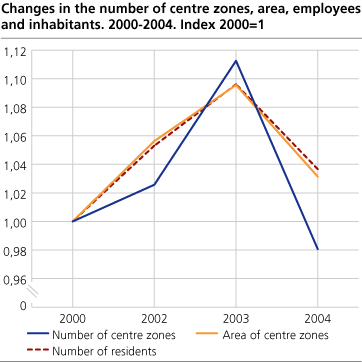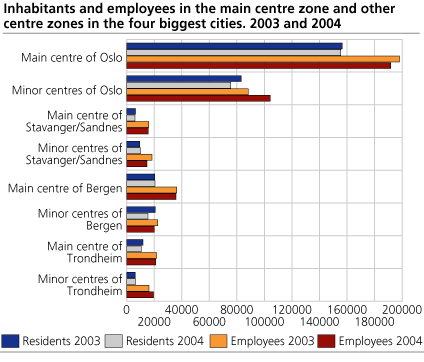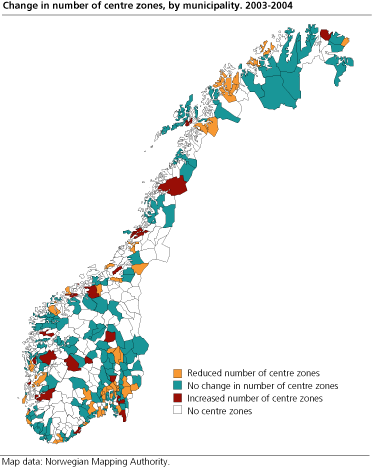Content
Published:
This is an archived release.
Fewer small centre zones last year
It was 610 centre zones distributed on 259 municipalities in Norway by January 1 2004. 153 centre zones disappeared during the last year while 63 new ones appeared. 15 municipalities lost their centre zones altogether. The number of employees in centre zones decreased in general, but increased in the largest city areas. It is, however, large variations among municipalities.
About 407 000 people, or 8.9 per cent of the inhabitants in Norway, live in centre zones - a decrease of 0.6 percentage points since last year. Decrease in the number of inhabitants follows decrease in the number, and also area of centre zones.
It has become fewer centre zones and less centre zone area during 2003. This in turn, has led to fewer inhabitants, businesses and employees in centre zones. One may assume that this is a consequence of fewer businesses defined as having centre zone functions.
The delimitation is done by automatic routines using a geographical information system and the use of information about buildings and enterprises extracted from administrative registers. The main purpose is to perform comparative statistical analyses of the land use in different parts of settlements.
The trend was broken in 2003
It was 610 centre zones with 407 388 inhabitants, 693 174 employees and 117 028 businesses as of 1 January 2004. This is a decrease in the number of centre zones by 12 per cent following an increase from 622 in the year 2000 to 692 in 2003. Area, inhabitants and employees also increased from 2000 to 2003. The decrease in the number and area of centre zones are followed by a decrease in inhabitants, employees and businesses.
The disappearance of centre zones is a direct consequence of the disappearance of businesses which was located in these areas and which was defined as having centre zone functions. New concentrations of businesses have led to the appearance of some new centre zones, but this does not compensate for the disappearance of the previous existing centre zones. 63 new centre zones are delimitated during 2003, while 153 have disappeared. In addition, some of the previously existing centre zones have been fragmented. All in all, these changes lead to 82 fewer centre zones in 2004 compared with 2003. It is especially businesses in the following industries, which have been closed down or moved from previously existing centre zones: Other business activities, real estate activities and other service activities.
It is the smallest centre zones, which appear or disappear from one year to another. Since even small businesses without employees are included in the criteria for delimitating centre zones, one must reckon with fluctuations in these smallest areas.
Not only district centres disappear
Urban settlements with 1 000 inhabitants or less and centres outside of urban settlements, lost 8 centra or close to 31 per cent during last year. The largest decrease in the number of centre zones, however, occurred in the cities with at lest 20 000 inhabitants, where 60 centre zones diappeared.
The largest centre zones are more stable
Changes occur, for the most part, in the smallest centre zones, while the larger zones are relatively stable when it comes to area, inhabitants and employees. In 2003, 53 centre zones had at least 2 000 employees, while this figure increased to 55 in 2004. It was 18 centre zones with at lest 5 000 employees both in 2003 and 2004.
The number of employees may be utilized as an indicator for activity in the centre zones. In the four largest cities (urban settlements) the number of employees increased by about 5 000 or 1.2 per cent the last year. The entire growth has occurred in the small centre zones in the urban settlement of Oslo (which includes not only Oslo municipality, but also surrounding municipalities) and Trondheim. The number of employees decreased somewhat in the main centre zone of all the four largest cities. In Bergen and Stavanger/Sandnes this decrease also occurred for the smaller centre zones.
The activity in centre zones in the largest cities has become more concentrated last year. While the number of employees increased, the area of centre zones decreased by 4.8 per cent. The number of inhabitants also decreased.
|
Important terms
Statistics Norway definition: 1. A center zone consists of one or more center kernels and a 100 metre zone around them. 2. A center kernal is an area with more than 3 different main types of economic activity with center functions. In addition to detail trade, governmental administration or health and social services or social and personal service must be present. The distance among enterprises must not be more than 50 meters. |
Digital centre zone boundaries delimited pr 1 January 2004 can be downloaded here.
Additional information
This statistics monitor the development in centre zones in relation to residents, employees and density. Based on automatic delimitation of the centre zones.
Contact
-
Erik Engelien
E-mail: erik.engelien@ssb.no
tel.: (+47) 91 12 55 45
-
Jørn Kristian Undelstvedt
E-mail: jorn.kristian.undelstvedt@ssb.no
tel.: (+47) 94 50 68 64



